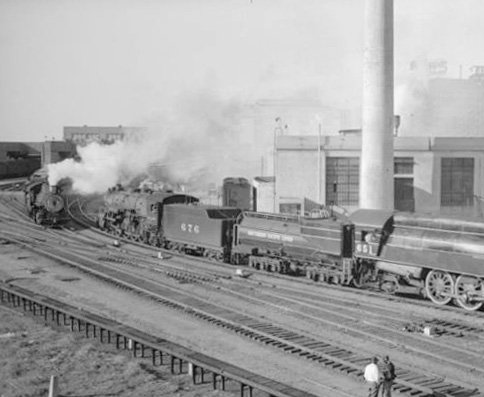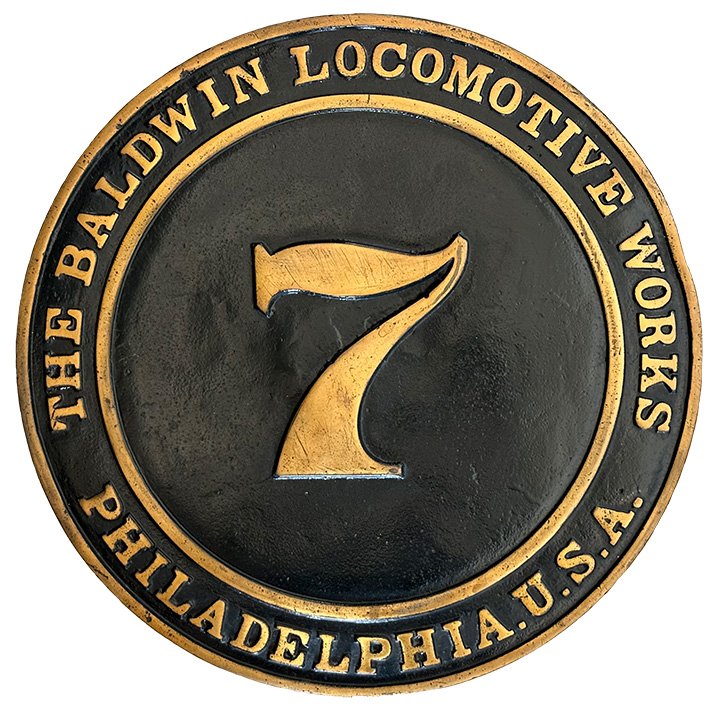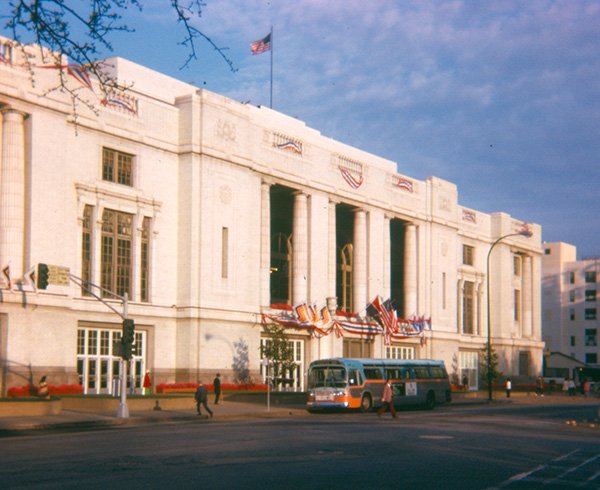Seven Spot Turns 100!
A local favorite, Dallas Union Terminal Locomotive #7 poses for this hot August, 2023 photograph while undergoing exterior cosmetic restoration at the Museum of the American Railroad.
This month marks 100 years since one of the most beloved and celebrated pieces in the Museum’s collection was built. Locomotive #7 has endured for a century, first as a work-a-day steam engine, and later as a museum piece. It was delivered new to the Dallas Union Terminal Company in October, 1923, where it became a common sight in downtown Dallas for 40 years before its eventual retirement in 1963.
Union Terminal #7 poses for its builder’s photograph at the Baldwin Locomotive Works’ Eddystone, PA plant in October, 1923. This is the only known builder’s view. -H.L. Broadbelt Collection
With the switchman riding the footboard, #7 threads trackage south of the Terminal. In this circa 1960 view, the Sam Houston Zephyr has just arrived on Track 9 from Houston, and at right in the photograph is the power house and smoke stack for the Terminal.
The 0-6-0 type oil-burning steam locomotive was an essential part of the terminal’s daily (and nightly) operations, shuffling cars between trains on the 11 station tracks during the peak years of rail travel. Dallas saw nearly 100 daily arrivals and departures through the bustling station. Many railroads provided “connecting service”, where cars were transferred from one train to another during station stops. It was common practice with sleeping cars, where first-class passengers effectively changed trains without leaving their accommodations.
During these brief layovers, locomotive #7 would grab cars from the rear of an incoming train and couple them to the rear of an outbound train – all while threading a labyrinth of tracks on a very tight schedule. The process was nothing short of a logistical feat; safely moving heavy equipment through the busy terminal while harnessing the power of steam often under adverse conditions. The engine also transferred mail and express cars to and from the neighboring Terminal Annex Post Office and the Railway Express Building.
The Seven Spot backs along Terminal trackage next to Southern Pacific road power likely from the Dallas-Houston Sunbeam.
#7 is readied for another day’s work at the Cadiz Street Roundhouse just south of the Terminal. Noticeable just below the headlight is a hood ornament from a 1947 Packard, no doubt a nice personal addition to the locomotive from the roundhouse crew.
Union Terminal #7 was built by the Baldwin Locomotive Works located just south of Philadelphia in Eddystone, Pennsylvania. It was constructed to a Southern Pacific S12 standard plan, having been tacked onto a larger order of switchers by the railroad. Despite its number, it was the only dedicated locomotive at the station and was kept in a constant state of readiness. The number “7” is believed to have derived from the seven participating railroads that jointly owned and operated the terminal. The locomotive was maintained at the Cadiz Street roundhouse just south of the station, and received major repairs at SP’s Ennis Shops. SP was a majority owner of Union Terminal.
The Seven Spot crew poses during switch moves in this priceless photograph captured on May 13, 1961. The original caption says “Willis Bell on right”.
Harvie A. Miller, one of the last engineers before #7’s retirement, poses during a visit to Fair Park on August 18, 2007 to celebrate his 90th birthday. Seven Spot crews often obliged requests of onlookers at the Terminal by providing cab rides during its daily operations. We have seen many visitors to the Museum over the years that fondly recall riding in the cab of #7 as children and their endearing moments with the crew.
The venerable engine faithfully served the station for 40 years, with shop forces proudly nurturing it along in later years. The operating crews gave countless cab rides to a loyal following that realized the last vestige of steam was in its twilight. Nearly a decade after diesels graced the post-war streamliners that called on Dallas, #7 soldiered on with its signature black smoke rising above the banks of the Trinity River west of downtown. Such a sight would undoubtedly cause alarm today!
By the early 1960s, #7 was tired and in need of a major overhaul. But with rail passenger service on the decline and steam almost extinct, the remaining railroads participating in the Union Terminal Company were reluctant to invest in heavy repairs. The decision was made to retire #7 after the railroads agreed to acquire an aging diesel switcher from the Santa Fe Railway. Following the Christmas holiday rush of 1962, DUT #7 was officially retired in January, 1963. The Santa Fe diesel was lettered for Union Terminal and numbered #8. It carried on switching duties until 1968 at which time the few remaining trains at DUT no longer offered connecting cars, and mail contracts were awarded to trucks.
In these rare views Seven Spot’s replacement, Dallas Union Terminal #8, an early EMD diesel-electric switcher, goes about its daily duties at the station in the mid-1960s.
Affectionately, dubbed “Seven Spot”, the locomotive was stored behind the terminal building on Track 1 awaiting an uncertain fate. In the summer of 1963, two of Dallas’ most prominent leaders Everett DeGolyer, Jr. and Joseph Rucker, Jr. would come together to save the engine and display it at Fair Park. In August of that year, #7 was fired one last time to steam onto the Fairgrounds during a ceremonial arrival. A gift of the Union Terminal company, it closed out an era as the last steam locomotive in regular service in Texas. At the same time, it debuted the Age of Steam Exhibit at the Fair that October and served as an anchor to the attraction for another 50 years. Brought together by their desire to save the Seven Spot, DeGolyer and Rucker are regarded as the founders of our Museum some 60 years ago.
A gift of the Union Terminal Company, the venerable Seven Spot is fired up one last time and proudly steams into the fairgrounds for its new life at the Age of Steam Exhibit. In this August, 1963 view, #7’s preservation is the culmination of the efforts of two prominent Dallasites – Joseph Rucker, Jr. (Assistant General Manager of the State Fair of Texas) and Everett DeGolyer, Jr. (a philanthropist, author, and rail historian whose family home is now the Dallas Arboretum). Both men are credited as founders of what is now the Museum of the American Railroad. The DeGolyer photograph and manuscript collection is available for research at the Fondren Library Special Collections at SMU.
In this dramatic view, Dallas Union Terminal #7 is deftly lifted onto a BNSF flatcar for transport to its new home in Frisco. In this view, taken October 31, 2012, the locomotive and tender were separated onto two flatcars due to the overall weight of the 0-6-0.
Today, we are proud to continue stewardship of Dallas’ only preserved native steam locomotive. It survived the move to Frisco and is currently undergoing repainting to celebrate its Centennial. Locomotive #7 remains a favorite among Museum goers, where it has been enjoyed by visitors for generations.
Dallas Union Terminal #7’s original builder’s plates are displayed here. At left is the Baldwin Locomotive Works brass number plate that adorns the smoke box door. At right is one of two Baldwin serial number plates affixed to both sides of the smoke box. These items are safely stored away, as they are quite desirable to collectors. Resin cast replicas are in their place on the locomotive. We look forward to another century of Dallas’ favorite locomotive – one that touched many lives in its distinguished career at Union Station!
Rebirth, Reunion
The Dallas Union Terminal Company was created in 1913 in response to the Kessler Plan for Dallas. The master plan called for the creation of one large train station to be located west of Downtown on the relocated banks of the Trinity River. The new “Union” station effectively consolidated five older depots scattered around Dallas that were choking the CBD with rail lines. It was owned and operated by the seven railroad companies serving Dallas at the time.
Union Terminal opened in October 1916, and endured two world wars, depression, and a post-WWII renovation until its eventual closure in May, 1969. In response to increased rail traffic, Locomotive #7 was purchased in 1923 to transfer rail cars between trains, as well as servicing facilities and the Post Office.
In the early 1970s, the terminal was purchased by the City of Dallas and repurposed as part of the Woodbine Development Reunion project. Amtrak became a tenant in 1974, followed by today’s Trinity Railway Express and DART light rail service. In 2019, the landmark structure was renamed Eddie Bernice Johnson Union Station in honor of Dallas’ longtime representative in Congress.
On March 14, 1974, Dallas Union Terminal officially became Union Station. This photo was taken that morning just prior to a rededication of the station following departure of Amtrak’s inaugural run of the new Inter American (today’s Texas Eagle). It marked the introduction of Amtrak service to Dallas, which prior to that date was the largest city in the U.S. without Amtrak service. Mayor Wes Wise officiated the rededication of the now Dallas-owned facility along with Adeline Harrison who would later play a key role in the development of DART.













